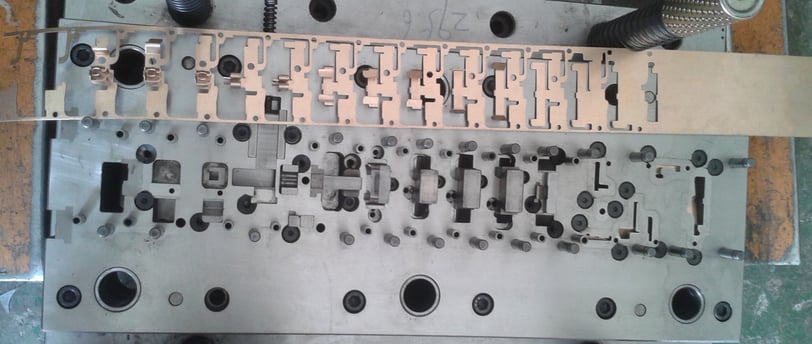A Complete Guide to the Care and Maintenance of Stamping Dies
1/27/2025


Introduction to Stamping Dies
Stamping dies are intricate tools utilized in the manufacturing industry to shape and form materials, predominantly metals, through a process known as stamping. This technique involves pressing a material, typically sheet metal, into a die that reflects the intended design. The significance of stamping dies in manufacturing cannot be overstated, as they are pivotal in producing a wide array of components ranging from simple washers to complex automotive parts. The efficiency and precision of stamping processes heavily rely on the quality and condition of these dies.
There are various types of stamping dies, each serving distinct functions tailored to meet specific production requirements. The most common classifications include progressive dies, compound dies, and single-station dies, among others. Progressive dies are designed to carry out multiple operations in a single pass, allowing for high-volume production with fewer setups. Compound dies, on the other hand, perform two or more operations simultaneously, which streamlines the manufacturing process. Single-station dies are employed for singular operations such as cutting or bending materials, often seen in low-volume production scenarios.
Understanding the design and functionality of stamping dies is essential for professionals in the manufacturing sector, as the right selection of dies can directly impact production efficiency and product quality. Proper care and maintenance is vital not only to ensure longevity but also to uphold the precision and performance of these tools. Neglecting the upkeep of stamping dies can lead to wear and tear, ultimately affecting the overall manufacturing processes. Consequently, implementing regular inspection and maintenance routines is essential for sustaining the operational integrity of stamping dies and optimizing production output.
Understanding Die Components
Stamping dies are intricate tools composed of various components, each serving a distinct role in the stamping process. The principal elements of these dies include die plates, punches, and countersinks, all of which contribute to the overall efficiency and precision of the operation.
The die plates function as the foundation of the stamping die. Typically constructed from hardened steel, these plates provide the structural integrity necessary to withstand high pressures during the stamping operations. The quality of die plates is paramount as they directly influence the die's longevity and resistance to wear. A well-maintained die plate ensures that deformation is minimized, thereby enhancing the accuracy of the stamped components.
Another critical component is the punch. The punch is responsible for displacing the material, forming the desired shape through compression. It is essential that the punch is manufactured from superior materials to withstand the wear caused by repeated use. Regular inspection and maintenance of the punch are vital since any wear can lead to dimensional inaccuracies, impacting the quality of the final product.
Countersinks, often overlooked, play an essential role in achieving clean edges on the stamped components. These components help to create a smooth transition on the surface, which not only improves aesthetics but also functionality during assembly. Their maintenance is crucial, as dull or damaged countersinks can lead to burrs and rough edges, detracting from the overall quality of the stamping results.
The machinery associated with these components, such as hydraulic or mechanical presses, also deserves attention. These machines must be calibrated correctly to ensure consistent performance. The interplay between the stamp die components and the machinery used affects the stamping process's effectiveness, demonstrating the importance of both quality and maintenance in achieving optimal outcomes.
Best Practices for Die Care
Maintaining stamping dies is crucial for ensuring consistent performance and longevity. Implementing best practices for die care not only extends the lifespan of the tooling but also enhances the quality of stamped products. Regular inspection is the first step in effective die maintenance. By systematically checking for signs of wear, deformation, or damage, operators can address minor issues before they escalate into significant problems that could lead to costly downtime.
Alongside regular inspections, the cleaning of stamping dies is paramount. Accumulation of debris, grease, or metal shavings can adversely affect the die's performance and lead to premature wear. It is advisable to adopt a cleaning schedule that includes removing any built-up residues using suitable solvents and brushes, ensuring all surfaces are free of contaminants. Clean dies operate more efficiently and yield higher quality results.
Lubrication also plays a vital role in die care. Using appropriate lubricants helps minimize friction between moving parts, reducing wear and tear. It is essential to apply lubrication according to manufacturer specifications, ensuring that the right type and amount of lubricant is used for specific dies. Regularly lubricated dies operate smoothly, resulting in decreased risk of breakdowns during stamping operations.
Finally, the storage of stamping dies must not be overlooked. Proper storage ensures that dies remain in optimal condition when not in use. Dies should be cleaned and lubricated before storage and placed in a controlled environment where humidity and temperature are regulated. Using protective cases or racks can prevent physical damage and contamination during storage. By adhering to these best practices for die care, operators can enhance die longevity, maintain high performance standards, and ultimately contribute to the overall efficiency of stamping operations.
Troubleshooting Common Die Issues
Stamping dies are essential tools in manufacturing, providing precision and efficiency. However, over time, users may encounter various problems that can affect performance. Recognizing these common die issues early can significantly reduce downtime and maintain product quality.
One prevalent issue is misalignment. This situation arises when the stamping die is not properly positioned relative to the material being stamped. Signs of misalignment include uneven stamped impressions or defective parts. To identify misalignment, operators should conduct regular inspections, checking that the die is securely fastened and aligned with the machine's indicators. If misalignment is detected, a technician should realign the die carefully, ensuring it is square and centered with the stamping surface.
Dullness is another common problem that can compromise the effectiveness of stamping dies. Dull dies produce poor-quality stamps, which can lead to increased scrap rates. Recognizing dullness often involves a visual inspection for wear and examining the quality of the stamped material. Maintaining sharp dies can be achieved through regular honing and sharpening, which should be done using appropriate techniques tailored to the die material.
Deformation, often resulting from excessive pressure or improper material management, can also affect die performance. Deformed dies may produce inconsistent shapes or lead to breakage if not addressed promptly. Operators should routinely measure dies for any signs of warping and assess their operational conditions. To prevent deformation, it is critical to adhere strictly to the recommended pressure settings and ensure suitable material compatibility.
Proactive measures such as consistent maintenance schedules, proper storage, and careful handling can greatly reduce the likelihood of these issues occurring. Through regular inspections and attention to detail, users can ensure the longevity and efficacy of their stamping dies.
Regular Maintenance Schedules
Establishing a regular maintenance schedule for stamping dies is vital for ensuring their longevity and optimal performance. The frequency of maintenance typically depends on the usage level and the type of work being carried out. For dies that are utilized daily, a rigorous schedule may be necessary, while those used infrequently may require less stringent checks. A proactive approach to maintenance can prevent costly downtimes and extend the operational life of the equipment.
Creating a maintenance log is an effective way to track inspections, repairs, and the overall condition of the stamping dies. This log should include details such as the date of maintenance, the type of work performed, any parts replaced, and observations regarding the dies' performance. Regular documentation serves not only as a reference for future maintenance but also aids in identifying patterns or recurring issues, allowing for timely interventions.
Regular checks should encompass several important factors, including visual inspections for signs of wear or damage, cleaning to remove debris and residues, and lubrication of moving parts to ensure smooth operation. It is also crucial to verify the alignment and calibration of dies to prevent defects during the stamping process. Additionally, evaluating the condition of related equipment, such as presses and transfer systems, is essential as these may affect the overall efficacy of the stamping dies.
In summary, adhering to a regular maintenance schedule tailored to the specific demands of stamping dies is key to enhancing their efficiency and reliability. By implementing a detailed maintenance log and focusing on critical check points, manufacturers can mitigate risks, maintain productivity, and ensure the quality of their stamped products.
Upgrading and Retrofitting Stamping Dies
In the fast-evolving manufacturing landscape, upgrading and retrofitting stamping dies is essential for maintaining operational efficiency and enhancing performance. As new technologies emerge, manufacturers are finding numerous advantages in modernizing their stamping equipment. This process involves the replacement or enhancement of components within existing stamping dies to leverage improved materials and technologies that promote superior outcomes.
The decision to upgrade or retrofit stamping dies often arises from the need for increased precision, longevity, and faster production rates. New materials such as advanced steels or composites can significantly enhance the durability and reliability of stamping dies, reducing maintenance costs and downtime. For instance, transitioning from traditional materials to high-performance alloys can provide better resistance to wear and deformation, ultimately leading to longer operational life and consistent part production.
Incorporating technology such as computer numerical control (CNC) or enhanced software for die design is another avenue for retrofitting. These technologies facilitate more accurate machining processes, enabling manufacturers to create intricate die shapes with precision that was once challenging to achieve. Additionally, implementing sensors or IoT devices in the stamping process allows for real-time monitoring and data collection, enhancing decision-making and operational efficiency.
Moreover, timely upgrades can often lead to improvements in product quality, less scrap production, and more adaptable manufacturing processes. This is particularly important in industries that demand high standards and rapid product iteration. Upgrading stamping dies not only optimizes production capabilities but can also allow businesses to respond effectively to changing market demands and customer requirements.
Ultimately, investing in the upgrade or retrofit of stamping dies can lead to significant gains in productivity and operational effectiveness. Manufacturers should evaluate their current stamping technologies regularly to ascertain when such improvements are necessary for sustaining competitive advantage.
Conclusion and Final Thoughts
In summary, the proper care and maintenance of stamping dies are crucial elements that can significantly influence their performance and longevity. Stamping dies are essential tools in various manufacturing processes, playing a vital role in achieving precise and consistent results. By adhering to the maintenance guidelines outlined in this guide, users can enhance the lifespan of their dies, reducing the frequency of replacements and the associated costs. Adequate maintenance not only prolongs the lifespan of the dies but also ensures that they operate at maximum efficiency, leading to improved productivity in stamping tasks.
Investing time in routine inspections, cleaning, and lubrication of stamping dies can yield considerable benefits. Regular checks can help detect wear and tear early, allowing for timely repairs and minimizing unexpected downtimes. Additionally, choosing high-quality dies from reputable manufacturers is instrumental in achieving superior performance. Quality dies are typically more durable and less susceptible to damage, ultimately resulting in a more economical choice over time.
It is imperative for operators and maintenance teams to prioritize effective maintenance practices for stamping dies. Establishing a consistent maintenance schedule tailored to the specific requirements of the dies and the production environment will ensure optimal functionality. The effort put into maintaining these tools will undoubtedly reflect in the quality of the end products, demonstrating that diligence in care pays off in increased accuracy and efficiency. By following these recommendations, users can safeguard their stamping operations, ensuring a consistent output and upholding the highest standards in manufacturing.
